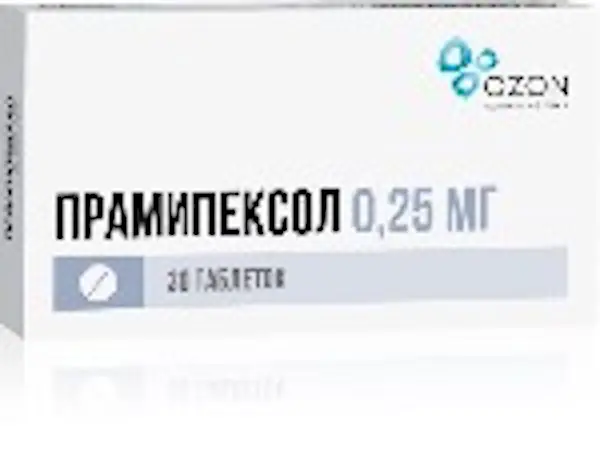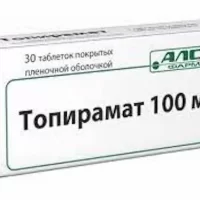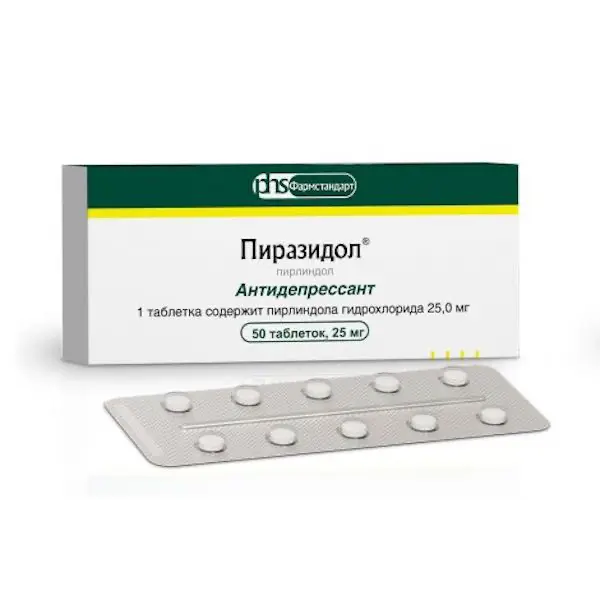Description
Pramipexole Pharmacodynamics
Pramipexole is a dopamine receptor agonist, with high selectivity and specificity, binds to D2 – dopamine receptors, having the most pronounced affinity for D3 – dopamine receptors. It reduces motor deficits in Parkinson’s disease by stimulating dopamine receptors in the striatum. Pramipexole inhibits the synthesis, release and metabolism of dopamine. Pramipexole in vitro protects dopaminergic neurons from degeneration occurring in response to ischemia or methamphetamine neurotoxicity. Reduces prolactin secretion (dose-dependent). The exact mechanism of action of the drug in the treatment of restless legs syndrome is currently unknown. Although the pathophysiology of restless legs syndrome is not fully understood, there is neuropharmacological evidence of primary involvement of the dopaminergic system. Studies using positron emission tomography have shown that moderate presynaptic dopaminergic dysfunction in the striatum may be involved in the pathogenesis of restless legs syndrome. Pramipexole in vitro protects neurons from levodopa neurotoxicity.
With long-term use (more than 3 years) of pramipexole in patients with Parkinson’s disease, there were no signs of decreased efficacy. When using pramipexole in patients with restless legs syndrome for 1 year, the effectiveness of the drug was maintained.
Indications
Symptomatic treatment of idiopathic Parkinson’s disease in adults (monotherapy or in combination with levodopa) at all stages of the disease, including late stages when levodopa effects weaken or become unstable and therapeutic effect fluctuations appear (end-dose wear-out or “on-off” phenomenon).
Symptomatic treatment of moderate to severe idiopathic restless legs syndrome.
Contraindications
Hypersensitivity to pramipexole or to one of the components of the drug. Age under 18 years (effectiveness and safety have not been studied).
Caution
Renal insufficiency, arterial hypotension, simultaneous use of dopamine receptor antagonists, sedatives, ethanol, cardiovascular diseases.
Administration during pregnancy and lactation
The effect of the drug on pregnancy and lactation in humans has not been studied.
The effect of pramipexole on reproductive function has been studied in animal experiments. Pramipexole had no teratogenic effect in experiments on rats and rabbits, but when administered in toxic doses to pregnant rats, pramipexole had embryotoxic effect.
The drug pramipexole should not be used in pregnancy unless absolutely necessary, when the potential benefit to the mother significantly exceeds the potential risk to the fetus.
Since pramipexole inhibits prolactin secretion in humans, it is assumed that the drug inhibits lactation.
Animal studies have shown that pramipexole may penetrate into breast milk.
The drug should not be used while breastfeeding. If therapy is necessary, breastfeeding should be stopped.
Dosage and administration
- Inside, regardless of the meal, with a little water. The daily dose is divided evenly into 3 doses. Calculation of doses is based on pramipexole dihydrochloride monohydrate.
- Symptomatic treatment of Parkinson’s disease Initial therapy
- The dose of the drug should be increased gradually, every 5-7 days, starting at 0.375 mg per day. To reduce the risk of side effects, the dose should be adjusted gradually until maximum therapeutic effect is achieved.
- Dose escalation scheme for Pramipexole
- Week 1
- Dose (mg) 3 × 0.125
- Total daily dose (mg) 0.375
- Week 2
- Dose (mg) 3 × 0.25
- Total daily dose (mg) 0.75
- Week 1
- Dose (mg) 3 x 0.5
- Total daily dose (mg) 1.5
- If further increases in the daily dose are necessary, add 0.75 mg per week to a maximum dose of 4.5 mg per day.
- Note that doses over 1.5 mg daily increase the incidence of somnolence.
- Maintenance therapy
- The individual dose should be between 0.375 mg and 4.5 mg per day. In both early and late stages of the disease, the drug is effective starting with a daily dose of 1.5 mg. Further dose changes should depend on the patient’s response to treatment and the development of undesirable effects. At the same time, it is not excluded that in some patients a dose higher than 1.5 mg daily may give an additional therapeutic effect, especially in the late stage of the disease, when a lower dose of levodopa is indicated. Discontinuation of therapy
- Sudden discontinuation of therapy with dopamine receptor agonists may lead to the development of a malignant neuroleptic syndrome.
- Pramipexole should be withdrawn gradually, at 0.75 mg per day until the daily dose reaches 0.75 mg, after which the dose is reduced by 0.375 mg per day (see section “Special Precautions”).
- Patients with renal insufficiency
- The dose of pramipexole depends on the creatinine clearance (CK).
- Initial therapy
- Patients with IQ over 50 ml/min: it is not required to reduce daily dose of the preparation; patients with IQ 20-50 ml/min: 0.125 mg 2 times per day (0.25 mg per day); patients with IQ less than 20 ml/min: 0.125 mg once per day.
- If during maintenance therapy renal function decreases, the daily dose of the drug is reduced by the same percentage by which CK decreases, i.e. if CK decreases by 30%, the daily dose of the drug should be reduced by 30%. The daily dose may be divided into two doses if CK is within 20-50 ml/min, or taken once daily if CK is less than 20 ml/min.
- Patients with hepatic impairment
- In patients with hepatic impairment, dose adjustment is probably not required since approximately 90% of the absorbed active substance is excreted by the kidneys, but the potential effect of hepatic impairment on the pharmacokinetics of pramipexole has not been studied.
- Patients receiving concomitant therapy with levodopa
- When receiving concomitant therapy with levodopa, it is recommended that the dose of levodopa be adjusted as the dose is increased, as well as during maintenance therapy with pramipexole. This is necessary to avoid excessive dopamine stimulation.
- Symptomatic treatment of idiopathic restless legs syndrome
- Initial therapy
- The recommended initial dose of pramipexole is 0.125 mg once daily 2 to 3 hours before bedtime. If additional symptomatic therapy is necessary, the dose may be increased every 4 to 7 days until a maximum dose of 0.75 mg per day is reached (as shown in the table below).
- Dose escalation schedule for Pramipexole
- Dosing steps Dose (mg), for use once daily, in the evening
- 1 0,125
- 2* 0,25
- 3* 0,50
- 4* 0,75
- 1 0.125 3* 0.50 3* 0.50 4* 0.75 *if needed
- The patient’s clinical response should be evaluated 3 months after initiation of therapy, after which the need for further therapy should be considered. If treatment is interrupted for more than a few days, the medication should be resumed by gradually increasing the dose as described above.
- Maintenance therapy
- The individual dose should be between 0.125 mg and 0.75 mg per day.
- Discontinuation of therapy
- Gradual dose reduction to discontinue therapy is not required.
- However, a recurrence of symptoms cannot be excluded. In clinical trials, only 10% of patients showed signs of worsening of symptoms after abrupt discontinuation of pramipexole, this effect was seen at any dose.
- Patients with renal insufficiency
- The excretion of pramipexole depends on renal function and correlates with creatinine clearance. For patients with creatinine clearance greater than 20. ml/min, no reduction in the daily dose is required. The use of pramipexole in patients on hemodialysis and with severe renal failure has not been studied.
- Patients with hepatic impairment
- In patients with hepatic impairment, dosage adjustment is probably not required since approximately 90% of the absorbed active substance is excreted by the kidneys, but the potential effect of hepatic impairment on the pharmacokinetics of pramipexole has not been studied.





